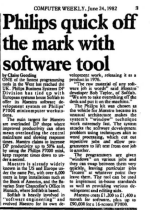bsdphk
Member
I can honestly say that I know absolutely nothing about the IV90.
In the donation with this tape was also a CDC disc pack, (If I remember correctly a 762), and the only label on it said something like "not to be used until checked by philips"
If Philips Data Systems was the European agent for Four Phase Systems, I guess there is a faint possibility that disc pack might contain relevant software.
We have a father&son team in Datamuseum.dk who spent most of 2023 recovering data from 762 disc-packs from a Christian Rovsing CR80 computer:
Danish Wiki (try google translate): https://datamuseum.dk/wiki/Projekter/CDC_9762_CR80_disk_packs
Github Project (in english): https://github.com/Datamuseum-DK/pico-smd-controller
I know there has been talk about a "pico-smd-drive" as well, but I do not know if it is a plan or if it is just talk.
I'll give that discpack a closer look next time I'm in, and if it looks well and sound, I can try to persuade them to read it, but it probably wont happen until some time in autumn, we're all volunteers, so not much activity during summer.
In the donation with this tape was also a CDC disc pack, (If I remember correctly a 762), and the only label on it said something like "not to be used until checked by philips"
If Philips Data Systems was the European agent for Four Phase Systems, I guess there is a faint possibility that disc pack might contain relevant software.
We have a father&son team in Datamuseum.dk who spent most of 2023 recovering data from 762 disc-packs from a Christian Rovsing CR80 computer:
Danish Wiki (try google translate): https://datamuseum.dk/wiki/Projekter/CDC_9762_CR80_disk_packs
Github Project (in english): https://github.com/Datamuseum-DK/pico-smd-controller
I know there has been talk about a "pico-smd-drive" as well, but I do not know if it is a plan or if it is just talk.
I'll give that discpack a closer look next time I'm in, and if it looks well and sound, I can try to persuade them to read it, but it probably wont happen until some time in autumn, we're all volunteers, so not much activity during summer.


